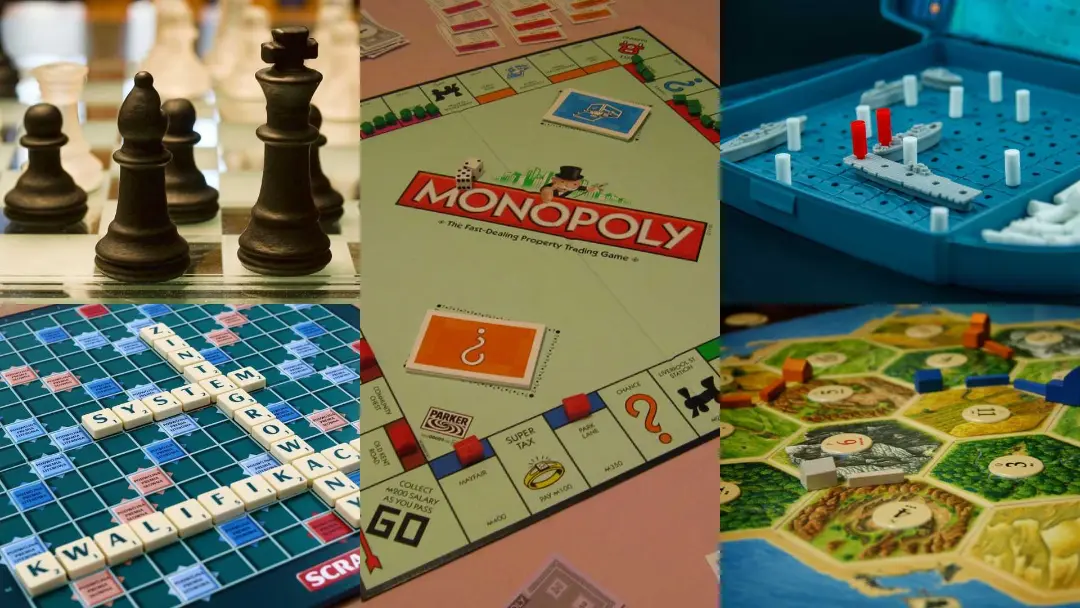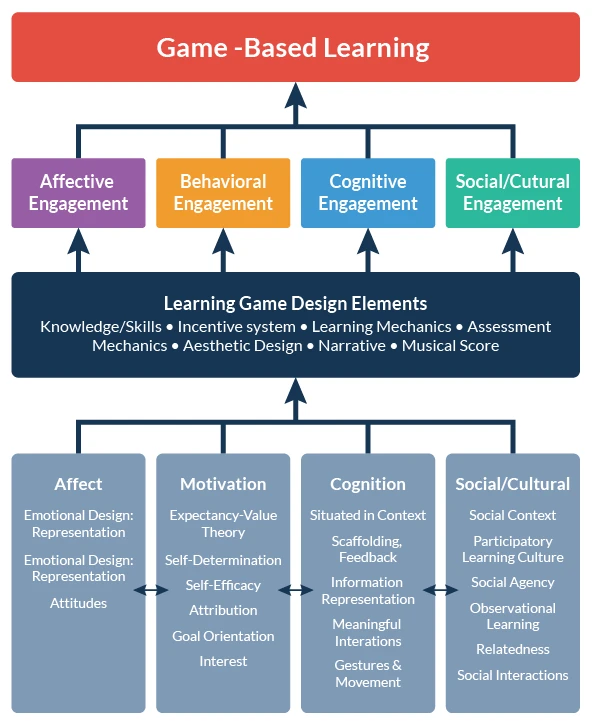Qué es la DGBL
Objetivos de aprendizaje
- Definición de DGBL
- ¿Qué es el compromiso?
- Cómo funciona el aprendizaje basado en juegos
- ¿Qué habilidades desarrolla el DGBL?
Términos clave
Para empezar nuestro viaje, tenemos que introducir algunos términos comunes:
- Juego
- Aprendizaje
- Aprendizaje digital basado en juegos (DGBL)
- Compromiso
¿Qué es un juego?
Volviendo al debate sobre lo que constituyen los "juegos" en relación con el aprendizaje, en primer lugar es importante reconocer que las definiciones han variado en función de las distintas disciplinas y perspectivas. Sintetizando varias de estas perspectivas sobre los juegos, el juego y la cultura, podríamos utilizar esta definición:
Un juego es un sistema en el que los jugadores participan en un conflicto artificial, definido por reglas, que da lugar a un resultado cuantificable.
Un juego es un sistema porque implica un conjunto de cosas (reglas, objetos, jugadores, etc.) que se afectan mutuamente dentro de un entorno para formar un patrón más amplio que es diferente de cualquiera de las partes individuales. Un juego también implica jugadores, participantes activos que interactúan con el sistema del juego para experimentar el juego. No todos los juegos necesitan un conflicto, una competición entre jugadores (por ejemplo, los juegos en solitario, como el solitario, o los juegos cooperativos). Todos los juegos implican reglas que proporcionan la estructura de la que surge la jugabilidad, al delimitar lo que un jugador puede o no puede hacer. Por último, esta definición afirma que todos los juegos implican algún tipo de resultado cuantificable: en su forma más simple, un estado de victoria o derrota.
Qué es el aprendizaje
Definir lo que constituye el aprendizaje basado en el juego en la DGBL exige reconocer la naturaleza controvertida del propio aprendizaje como concepto. En términos generales, hay dos metáforas generales que han sido históricamente utilizadas por la comunidad de investigación educativa para definir y describir el aprendizaje. 1. El primer punto de vista caracteriza el aprendizaje como adquisición, ya sea la adquisición de conocimientos, habilidades, disposiciones, comportamientos u otros resultados considerados deseables por los educadores y las instituciones. En general, esto coincide con lo que los académicos denominan una perspectiva cognitiva del aprendizaje, que hace hincapié en los procesos mentales internos como la memoria, la toma de decisiones, el pensamiento y la construcción del conocimiento como elementos fundamentales del aprendizaje. También se opone a las concepciones conductistas del aprendizaje, que tienden a hacer hincapié en los comportamientos observables como indicadores del aprendizaje. 2. La segunda metáfora caracteriza el aprendizaje como participación y hace hincapié en los procesos de socialización, tutoría, participación y práctica social. En el ámbito de la educación, esta metáfora suele informar a los estudiosos que se identifican con una perspectiva sociocultural del aprendizaje, que tiende a destacar las prácticas sociales, las identidades y las relaciones como elementos centrales del aprendizaje.
¿Qué es el aprendizaje basado en juegos?
Traducción realizada con la versión gratuita del traductor www.DeepL.com/Translator
Game-based learning is a pedagogical approach that involves designing learning activities through games where the game characteristics and game principles inhere within the learning activities themselves.
The design of more engaging curriculum needs to include techniques that teaches students how to be critical, confident and creative as well as abilities that they will need for success in the work-a-day future life. Games have this techniques and features.
Gaming is inherently motivating, which may allow learners to gain skills and knowledge, by leveraging entertainment and weaving it within learning environments. Research studies indicate that video games in particular have great engagement and education related benefits.
📽 #VIDEO Games and the Future of Education
Different types of GBL
In order to understand GBL better, its different types can be examined along with taking the following into consideration: the place where the game happens, and the environment in which the students play. The three types of GBL are:
Board games

Board Games are usually played by one or more players around a table (they are also called Tabletop Games). Monopoly can be considered an educational game. It has all the necessary elements: a story, characters, points, competition, and many other aspects. There are many examples of Monopoly-like games for schools with modified rules for different subjects, like History Monopoly or Math Monopoly. Board Games are used with great success to explore and teach. But it's not the focus of this course.
Real life games

The environment here is the real world. This is probably the most motivating, but also the most stressful type of game. In this kind, students must move, act, use their body and their minds in order to play. This is the most immersive type and it provokes students in almost every aspect of their learning. Since there is the possibility to move into a certain space, the real life game is often connected to the theatre. It’s easy to find role play activities, as well as simulations or drama in this type of game learning. Students act “as if they were” a character of the game, make decisions according to their goals, the environment, and the rules (Living Role Playing Game). We'll see that the Augmented Reality technology allows digital games to be played in the real world.
Digital games
Just as analog games can take on a variety of forms, so too can digital games appear on a multitude of computer-based electronic platforms. These include games installed as software on personal computers, as well as games played through television-attached gaming consoles such as the Sony PlayStation or Microsoft Xbox. Digital game platforms also include dedicated handheld platforms, such as the Nintendo Gameboy and its various incarnations, as well as mobile smartphones and tablet computers. These games can be engaged as a single player, with multiple players in a single physical location, or with players across distances using online connective features.
Digital vs Analog games
There are at least four key traits that distinguish digital games from non-digital ones. 1. The first is that digital games can offer experiences of interactivity that are generally characterized by both immediacy and focus. This is largely by virtue of the fact that digital games are programmed into computers. Programming provides increased immediacy of feedback because the system is automated to respond to player input. Programming also provides a narrowed range of interactivity because possible player inputs and outcomes are limited by what a digital game developer has programmed into the software. 2. Second, digital games and digital media more broadly make use of a computer’s affordances for collecting, storing, retrieving, manipulating, revealing, or even concealing information in the form of images, text, animations, sound, and even player behavioral data. 3. Third, due to their computational nature, digital games have the potential to automate systems and procedures that may be far more complex for non-digital games to simulate. Examples of these complex systems include simulated environmental features in computer-based role-playing games: terrain–movement interactions, lines of sight, weather cycles, and even interactions with animals or non-player characters in the virtual game world. 4. Finally, many (although not all) contemporary digital games have the ability to facilitate communication between players across networks, such as the online networks that connect players in multiplayer, internet-connected games. These communication-facilitating features can include technologies that enable voice or text chat between players within a particular game.
What is Digital Game-Based Learning?
Digital game-based learning refers to learning by solving problems or accomplishing tasks through computers, mobile phones, or tablets. There are several elements in digital game-based learning, such as fun, play, goals, competition, and problem-solving.
Studies have investigated DGBL in different subjects, such as Literacy, Maths, Sciences, and STEAM. The results indicate that DGBL could improve students’ learning motivation, learning performance, reduce their cognitive load and anxiety.
{: .highlight }
Game based learning (GBL) is a type of game play that has defined learning outcomes.
Digital game based learning (DGBL) refers to using actual digital video games as learning tools.
A critical appraisal of the game-based aspect of DGBL can help better situate the usage of this concept in theory and practice. Building on learning as an acquisition metaphor, one way to define game-based learning in DGBL is by the use of digital games to promote the acquisition of a variety of knowledge, skills, dispositions, or other educational outcomes. According to this definition, learning is game-based when digital games, or certain elements of digital games such as scorekeeping, are applied toward identifiable outcomes defined by educators or institutions.
Another framing of DGBL learning as participation metaphor, characterizes the game-based aspect of DGBL as an inherent part of meaningfully participating in - that is, playing - games, regardless of their connection to some external educational outcome. According to this definition, learning is always happening when someone plays a game. Having to solve problems, overcome obstacles, or collaborate with others within and around games are all dimensions of learning. As game designer and theorist Raph Koster noted in A Theory of Fun book, a game is only “good” to the degree that it is “fun,” and a game is only fun to the degree which players are being challenged to learn to be successful in that game space.
Gamification
Gamification, often categorized as a subconcept of DGBL, describes the implementation of certain aspects of digital games (visual displays of progress, automated reward systems, scoring leaderboards, virtual avatars, and others) into non-gaming contexts such as education, business management, marketing, and even physical exercise programs.
Engagement
Engaging students in classroom content is always a hard task, and traditional forms of education have become expected and somewhat redundant, that the learning capacities of students are very weak. When students aren’t engaged, they’re more likely to disrupt class, less likely to accept challenges, have lower grades, and aren’t confident in their ability to learn.
Additionally, sustaining engagement is very important to ensure that the student is gaining the most out of their learning experience and that their cognitive skills are always stimulated. Engaging through educational video games that are built on educational content has proven to be a great way not only to keep students engaged but also to deliver complex theories/topics in an interactive manner allowing students to have a deeper comprehension of the content.

Motivation
Motivation is the force behind human performance. It can arise from physiological or psychological needs, thoughts, or emotions. Our physiological needs help us preserve optimal physical functioning, while psychological needs typically help us thrive. The source of motivation can come from within ourselves or be external to us. Both games and learning have to do with motivation, and we'll analyze this topic extensively in next chapter.
Unit review
Now that we have established what is game-based learning and why using educational video games is beneficial, please respond to the following questions:
- who can use DGBL? (students, everyone, teachers, kids)
- why is DGBL so powerful? (cheap, easy, engaging)
-
is Engagement good for learners? (yes, no, we don't know yet)
-
Create your own definition of game-based learning
- How do you believe educational video games would support your pedagogical approaches and enhance your teaching methods?
- How would you introduce educational video games in your classroom?